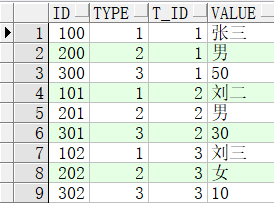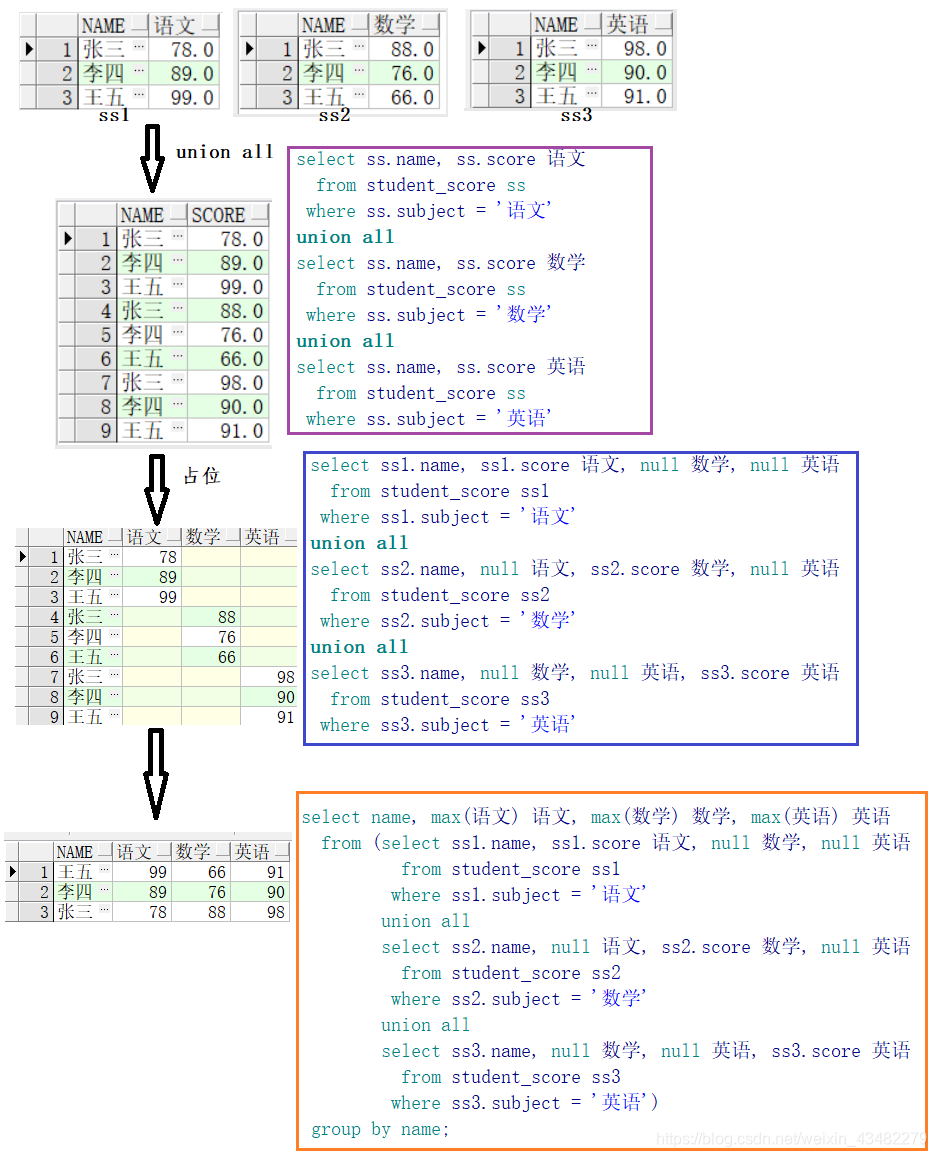1、中国移动sql面试题:
create table test(
id number(10) primary key,
type number(10) ,
t_id number(10),
value varchar2(5)
);
insert into test values(100,1,1,’张三’);
insert into test values(200,2,1,’男’);
insert into test values(300,3,1,’50’);
insert into test values(101,1,2,’刘二’);
insert into test values(201,2,2,’男’);
insert into test values(301,3,2,’30’);
insert into test values(102,1,3,’刘三’);
insert into test values(202,2,3,’女’);
insert into test values(302,3,3,’10’);
请写出一条查询语句结果如下:
姓名 性别 年龄
张三 男 50
【重点】行转列,group by分组多行合并为一行。
解析:
1、运行上述代码,再进行表查看select * from test;
2、实现行转列
1 | select decode(type, 1, value) 姓名, |
 3、多行合并为一行。首先使用group by分成三组,然后每组的每一条记录用max得到非空值(用min()也可以)
3、多行合并为一行。首先使用group by分成三组,然后每组的每一条记录用max得到非空值(用min()也可以)
1 | select max(decode(type, 1, value)) 姓名, |

2、一道SQL语句面试题,关于group by
表内容:
2005-05-09 胜
2005-05-09 胜
2005-05-09 负
2005-05-09 负
2005-05-10 胜
2005-05-10 负
2005-05-10 负
如果要生成下列结果, 该如何写sql语句?
1 | 胜 负 |
create table tmp(rq varchar2(10),shengfu varchar2(5));
insert into tmp values(‘2005-05-09’,’胜’);
insert into tmp values(‘2005-05-09’,’胜’);
insert into tmp values(‘2005-05-09’,’负’);
insert into tmp values(‘2005-05-09’,’负’);
insert into tmp values(‘2005-05-10’,’胜’);
insert into tmp values(‘2005-05-10’,’负’);
insert into tmp values(‘2005-05-10’,’负’);
1 | select * from tmp; |
3、create table STUDENT_SCORE
(
name VARCHAR2(20),
subject VARCHAR2(20),
score NUMBER(4,1)
);
insert into student_score (NAME, SUBJECT, SCORE) values (‘张三’, ‘语文’, 78.0);
insert into student_score (NAME, SUBJECT, SCORE) values (‘张三’, ‘数学’, 88.0);
insert into student_score (NAME, SUBJECT, SCORE) values (‘张三’, ‘英语’, 98.0);
insert into student_score (NAME, SUBJECT, SCORE) values (‘李四’, ‘语文’, 89.0);
insert into student_score (NAME, SUBJECT, SCORE) values (‘李四’, ‘数学’, 76.0);
insert into student_score (NAME, SUBJECT, SCORE) values (‘李四’, ‘英语’, 90.0);
insert into student_score (NAME, SUBJECT, SCORE) values (‘王五’, ‘语文’, 99.0);
insert into student_score (NAME, SUBJECT, SCORE) values (‘王五’, ‘数学’, 66.0);
insert into student_score (NAME, SUBJECT, SCORE) values (‘王五’, ‘英语’, 91.0);
3.1得到类似下面的结果
1 | 姓名 语文 数学 英语 |
1 | --至少使用四种方式写出 |
下面用join方法,可以使用nutuarl join或者join on。
注意:
1、如果使用nutuarl join,连接中使用的列不能有限定词。因为nutuarl join会从两张表中找到相同的列做连接。score会导致错误。
2、如果使用nutuarl join,相同的关联列在选择列表中,不能用表名来指示(t1.name)。会报t1.name标识符错误。
1 | --错误一 |
注意:如果使用join on,和自然连接相反,必须在选择列表中指明,查找的相同列是哪个表中的(t1.name),否则会报未明确定义列的错误。
1 | --错误 |
方法四可以使用全集
1 | select name, max(语文) 语文, max(数学) 数学, max(英语) 英语 |

3.2有一张表,里面有3个字段:语文,数学,英语。其中有3条记录分别表示语文70分,数学80分,英语58分,请用一条sql语句查询出这三条记录并按以下条件显示出来(并写出您的思路):
大于或等于80表示优秀,大于或等于60表示及格,小于60分表示不及格。
显示格式:
Name 语文 数学 英语
张三 及格 优秀 优秀 1 | select name, |
4、请用一个sql语句得出结果
从table1,table2中取出如table3所列格式数据,注意提供的数据及结果不准确,只是作为一个格式向大家请教。
1 | table1 |
create table yj01(
month varchar2(10),
deptno number(10),
yj number(10)
);
insert into yj01(month,deptno,yj) values(‘一月份’,01,10);
insert into yj01(month,deptno,yj) values(‘二月份’,02,10);
insert into yj01(month,deptno,yj) values(‘二月份’,03,5);
insert into yj01(month,deptno,yj) values(‘三月份’,02,8);
insert into yj01(month,deptno,yj) values(‘三月份’,04,9);
insert into yj01(month,deptno,yj) values(‘三月份’,03,8);
create table yjdept(
deptno number(10),
dname varchar2(20)
);
insert into yjdept(deptno,dname) values(01,’国内业务一部’);
insert into yjdept(deptno,dname) values(02,’国内业务二部’);
insert into yjdept(deptno,dname) values(03,’国内业务三部’);
insert into yjdept(deptno,dname) values(04,’国际业务部’);
1 | --这题中,table2没有用到 |